Skymines is a reimplementation of the 2015 title, Mombasa, which basically means a designer has taken a game that already exists and reskinned it with maybe a few rules tweaks. Skymines lets you mine the moon and invest in promising companies to make a fortune. The star mechanic in Skymines is the card programming and hand management system that requires careful and clever planning. The game provides a deep player interaction that a lot of other euro games miss, and all players can invest in any or all of the four companies. The game can be played with 1-4 players and plays in 2-3 hours. The game is a higher complexity game known as a medium to heavy euro game. The game is designed by both Viktor Kobilke and Alexander Pfister and is published by Pegasus Spiele, known recently for some of their great newer titles such as Carnegie. I have also reviewed some of their other titles that you should check out, like Framework and FYFE.
What’s in the Box?
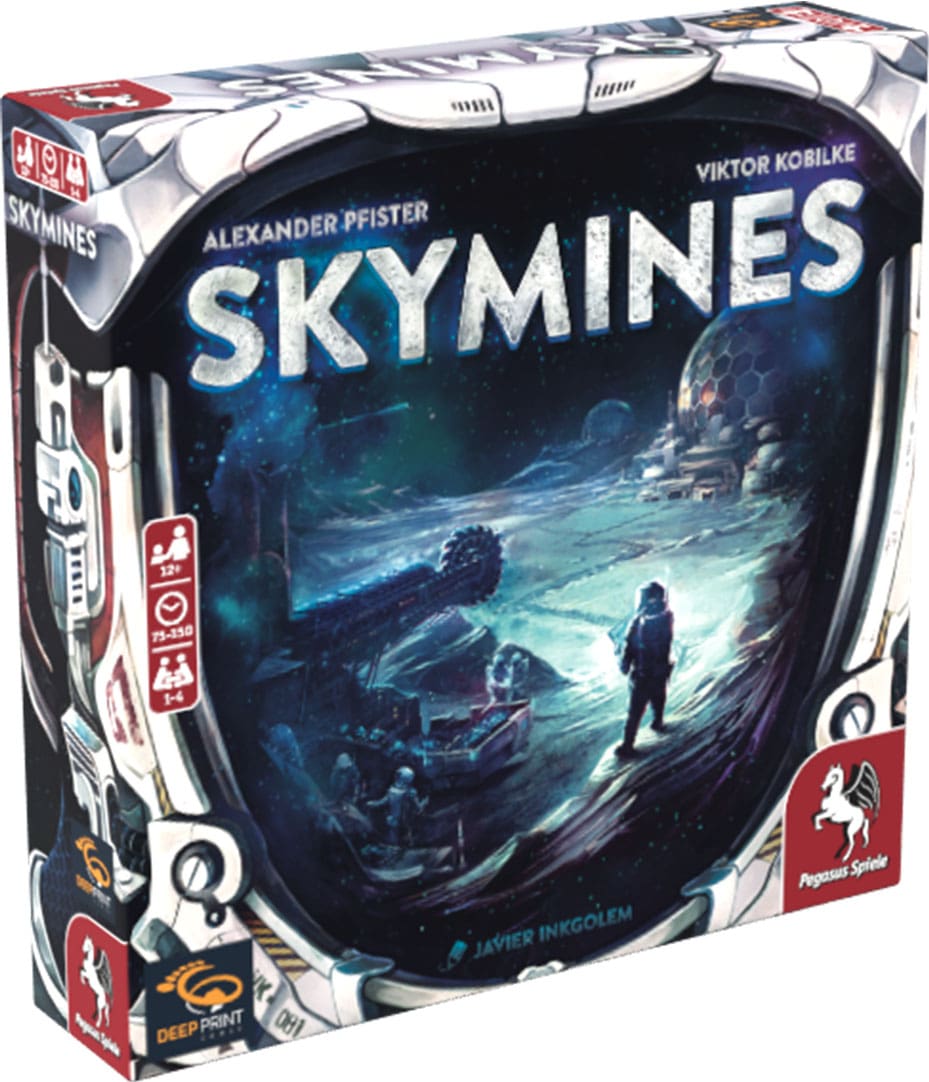
- 1 Double-sided game board
- 4 Double-sided player boards
- 5 Double-sided company tracks
- 44 action cards
- 5 track cards
- 36 Starting actions cards
- 4 Single-energy cards
- 4 Bonus tiles
- 10 Starting research tokens
- 8 ON/OFF markers
- 72 Research plans
- 6 Special research plans
- 60 CrypCoin
- 4 Player tokens
- 20 Bonus markers
- 16 Track markers
- 1 First player marker
- 60 Outposts
- 4 Helium-3 markers
- 4 Upload markers
- 1 Scoring pad
- 4 Overview sheets
- 4 Luna Tokens
- 12 One-time bonus markers
- 20 Shuttles
- 19 Luna cards
- 6 Mission cards
- 6 Threat cards
How’s It Play?
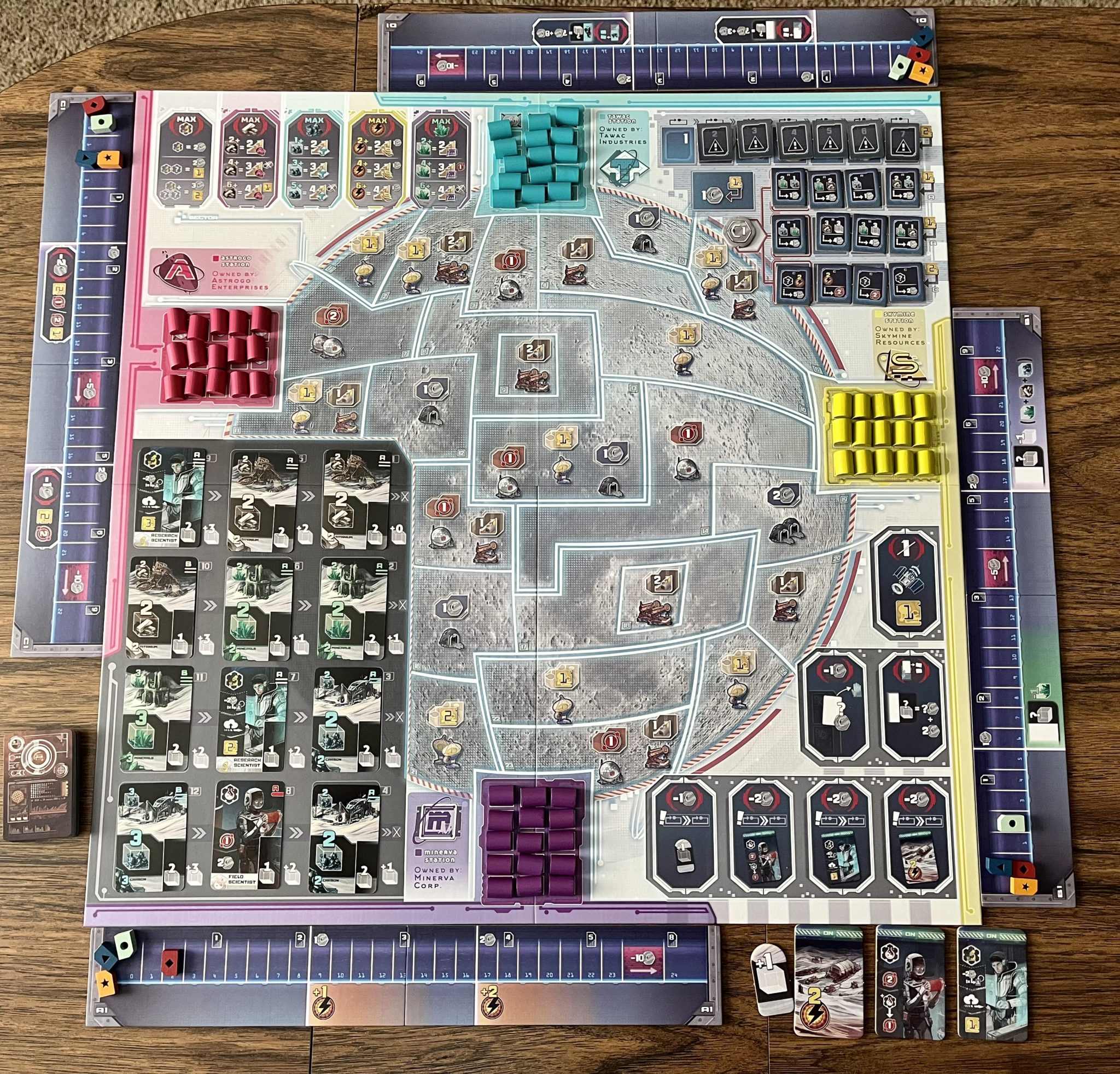
The goal in the game is to earn the most CrypCoin. The best and most important way to do this is by investing in the 4 companies on the board and spread their outposts across the map. When players invest resources into a company, each share in a company becomes more valuable. You also then move up on the company’s track to receive more shares in that company. So it takes a double approach: if another player is building out a specific company, you might want to start moving up on that company’s track to gain more shares in it. Besides focusing on gaining shares and developing a company, players can store helium and upload research on their research track to gain additional CrypCoin.
To be super clear, you gain money by shares you have in each company which is multiplied by its value. Its value is relatively higher when there are more outposts placed on the map of that company and by the ending cash you have in hand at the end of the game. The last value your helium-3 marker has passed on its track, and the last value your upload marker has passed on your research track are both additional ways to gain more money at the end of the game.
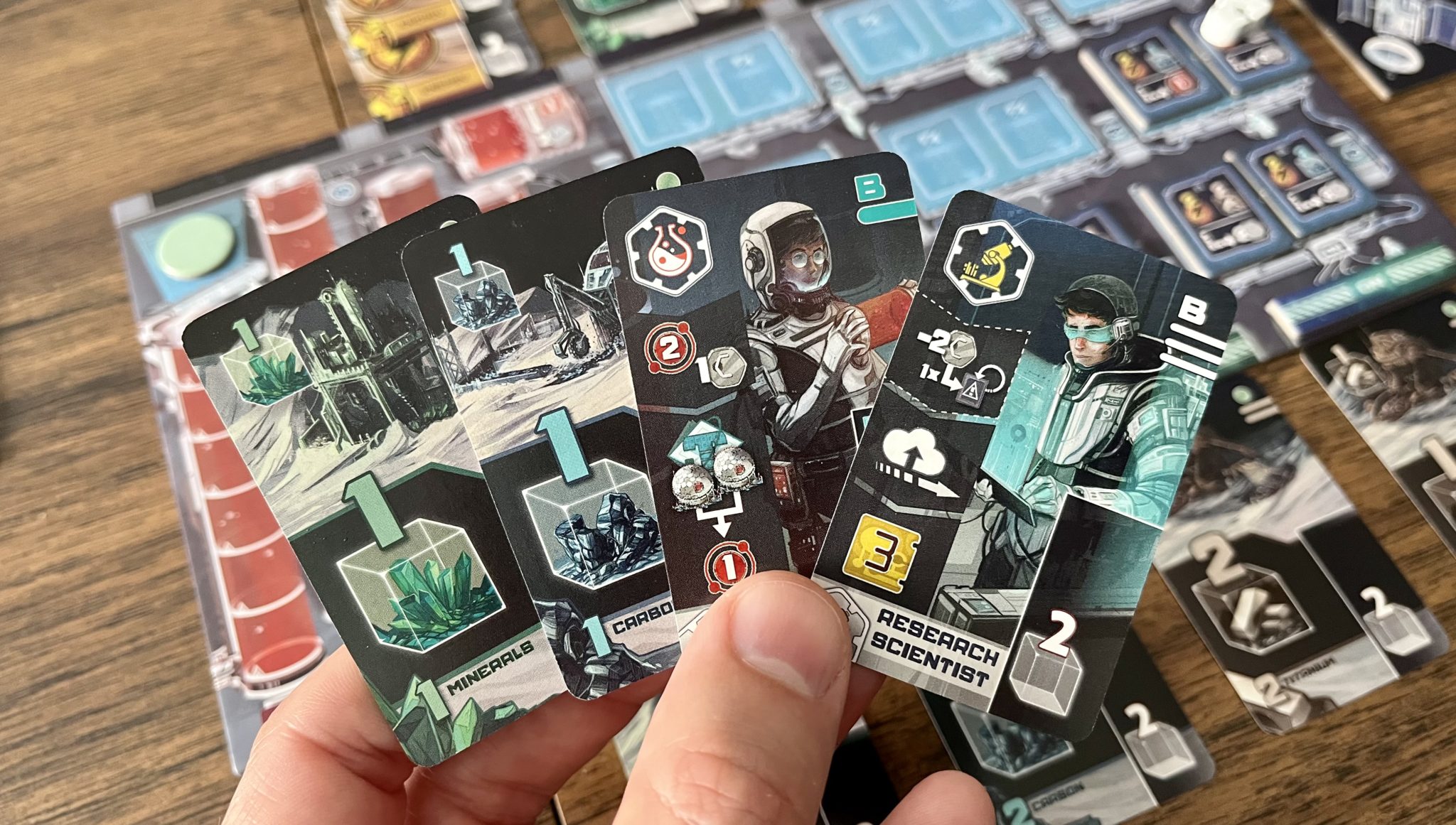
The game is always played over 7 rounds, and each round consists of 3 phases. These phases are: 1. Planning phase 2. Action phase and 3. Preparation phase for the next round.
Planning Phase –
Players have a deck of cards and will be able to gain more with certain actions. Players choose 3 at the beginning of the round but this can become 4 or 5 as the game goes on. But these chosen cards are first placed face down into your action slots on your player board. These cards won’t be available for you for a while after this round, as they will be placed into resting slots where you will slowly gain them back. When all players are ready, these cards are flipped over for all to see.
Action Phase –
The player with the first player marker begins this phase by taking one turn. The player to their left then takes a turn, then the next player, and so on until a player has to pass and drop out of the phase. So this is a juicy part of the game, and this phase will will take the majority of the time in the game. Actions consists of:
- Using 1 or more resource cards of a single type in your action area.
- Use all energy cards in your action area.
- Use 1 research scientist card in your action area.
- Use 1 field scientist card in your action area.
- Place 1 bonus marker.
- Drop out of the action phase.
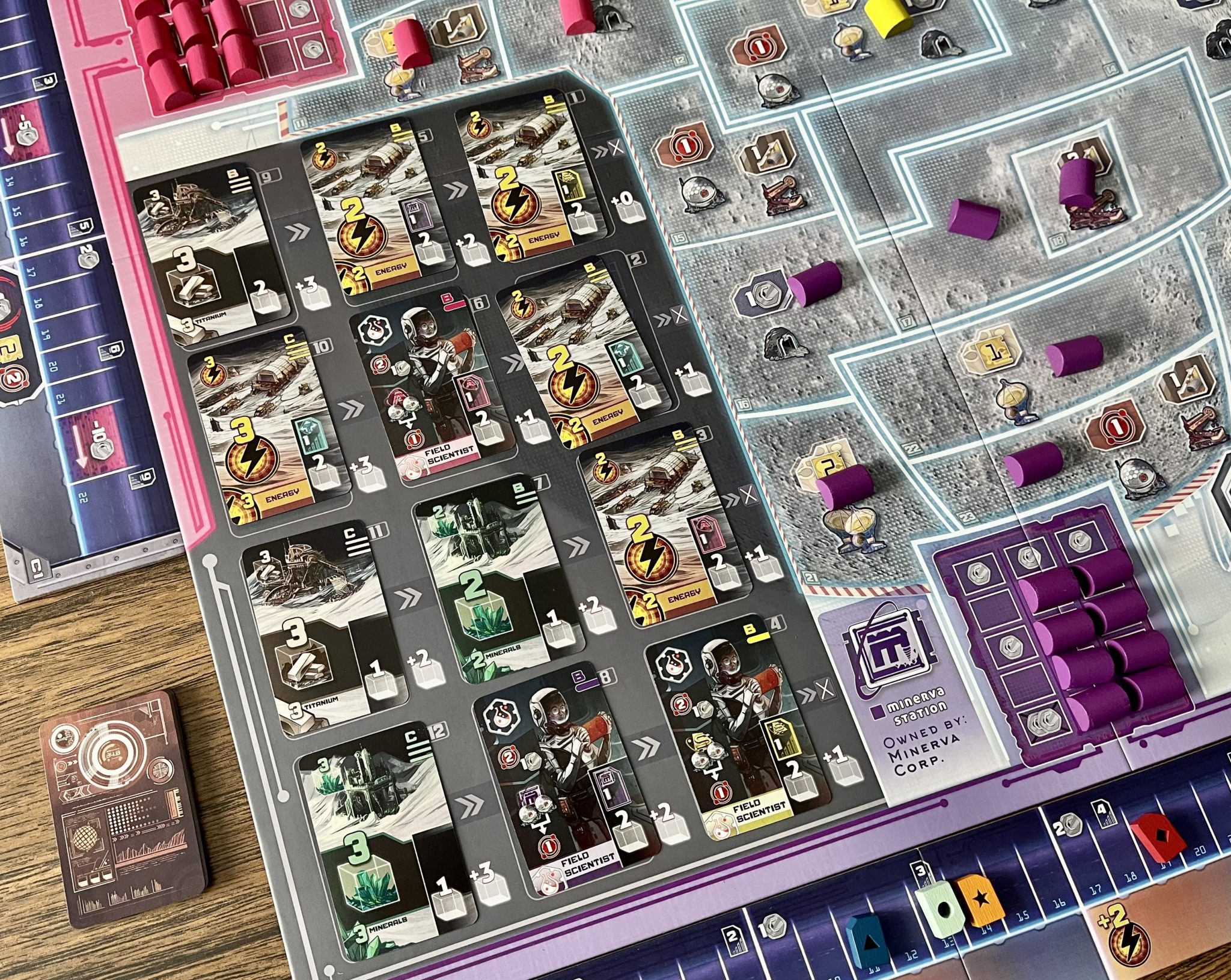
1. Using 1 or more resource cards of a single type –
You add up the total resource value, which could be the value on the one card, or if using multiple cards, could be the added up value of all cards. With this value you can acquire 1 card from the card display. The cost of the card needs to be equal to or lower to your total resource value. The card display will list the cost from a combination of what’s listed on the bottom right of the card plus the value placed on that card’s slot. The card goes right to that player’s hand of cards that can be used next round.
A player can also instead advance on 1 or more company tracks. Remember this is how you gain shares of stock in that company. For each value, move one of your track markers 1 space forward on that company’s track. You are allowed so split up your movements between companies to allow for more strategic planning. Sometimes when moving past certain spaces players can gain additional actions to take, or abilities to help them.
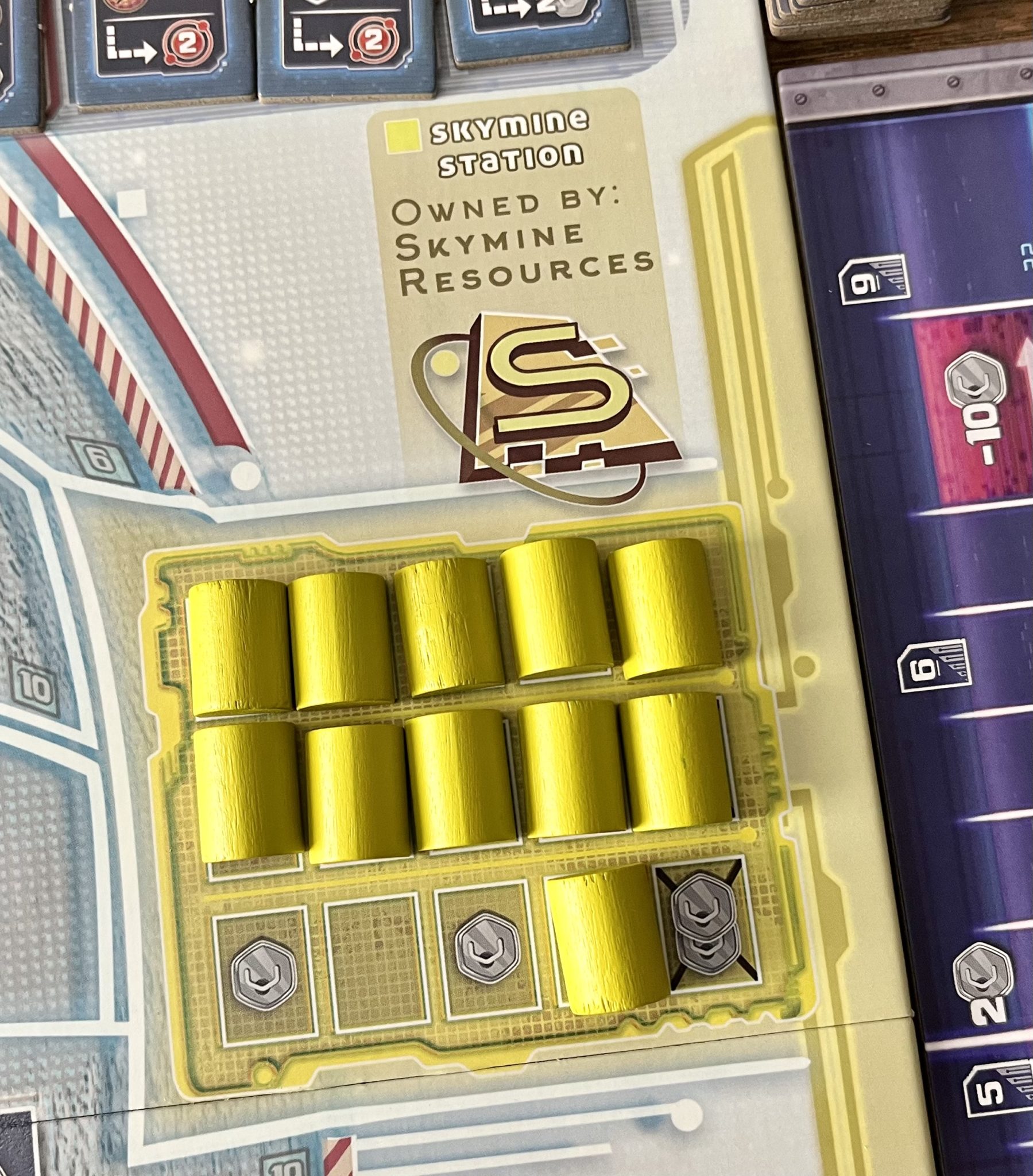
2. Using all energy cards –
You must use ALL energy cards to do this action. You add up the total value and use it to expand 1 company. You then move outposts out onto the map with each line costing 1 value of energy. If there is a double line, it costs 2 energy. As outposts come off, coins appear that raise the value of that company. As players place out outposts, they can take the actions on the space where an outpost is added. Rewards might let you gain coins, moving up your marker on that company’s track, moving up your helium-3 marker, or receiving research points to use to gain research tiles to place on your research track.
Your research track is made by adding tiles to it, and then completing the requirement shown on the tile to move your research marker up on it. Many times this is by having certain blue of specific cards in your action zones, or by having a type of scientist face up in your action zone.
3. Using 1 research scientist card –
You can first pay 2 coins to flip over a research plan that you either don’t want to complete or maybe won’t be able to for a while. When the tile is flipped over, you can move your marker past this tile quicker without needing to complete whatever requirement was shown on that tile. You then move your upload marker as far forward on your research track as you would like, but only if those requirements are completed. You cannot move past any empty slots where no tiles are placed.
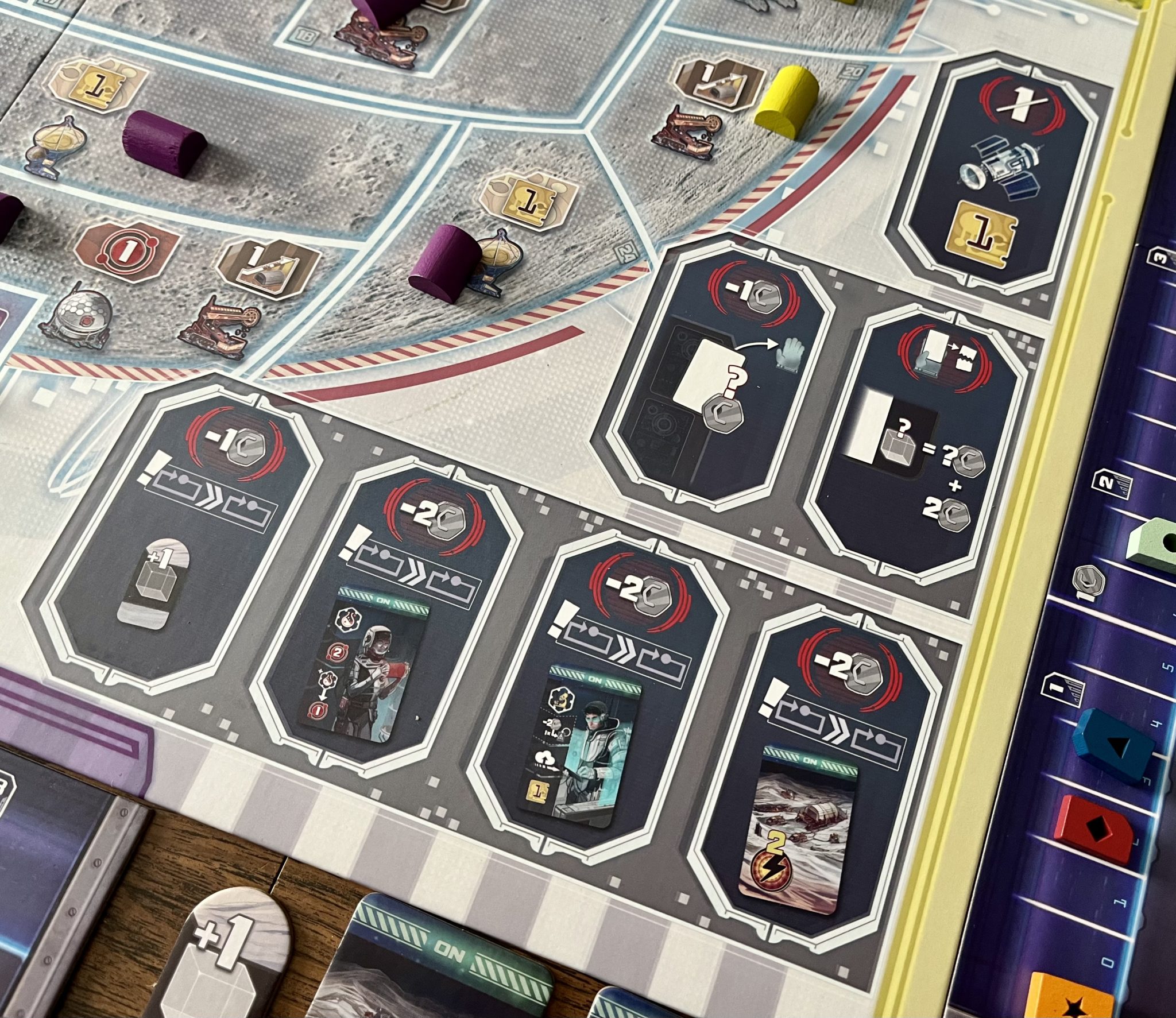
4. Use 1 field scientist card –
This action lets you move your helium-3 marker up on its track the number shown on that card. And then that player will be able to collect the amount of coins shown on that card from the bank.
5. Place 1 bonus marker –
With this action the player takes one of their bonus markers and places it onto a vacant bonus space on the board. That player will then take the rewards. There are a variety of actions, but 5 of them are similar in which you will need to have the majority of a certain resource when compared to all face up cards from all other players. That player will then add up their own value and take the shown action which for most is moving up on a certain company’s track. Other bonuses reward a player with an additional card to use next round or let them pay money to gain a specific reward. There is also a space to become first player.
6. Drop out of the Action phase –
To take this action, all cards in the action zone need to be face down. The player picks 1 pile of their resting zone. This will be 1 card after round 1, but as the game progresses it can be more. The last part of this phase is placing cards from your active zone that you just used into resting slots. These cards won’t be used until you choose that pile next time when taking this same action.
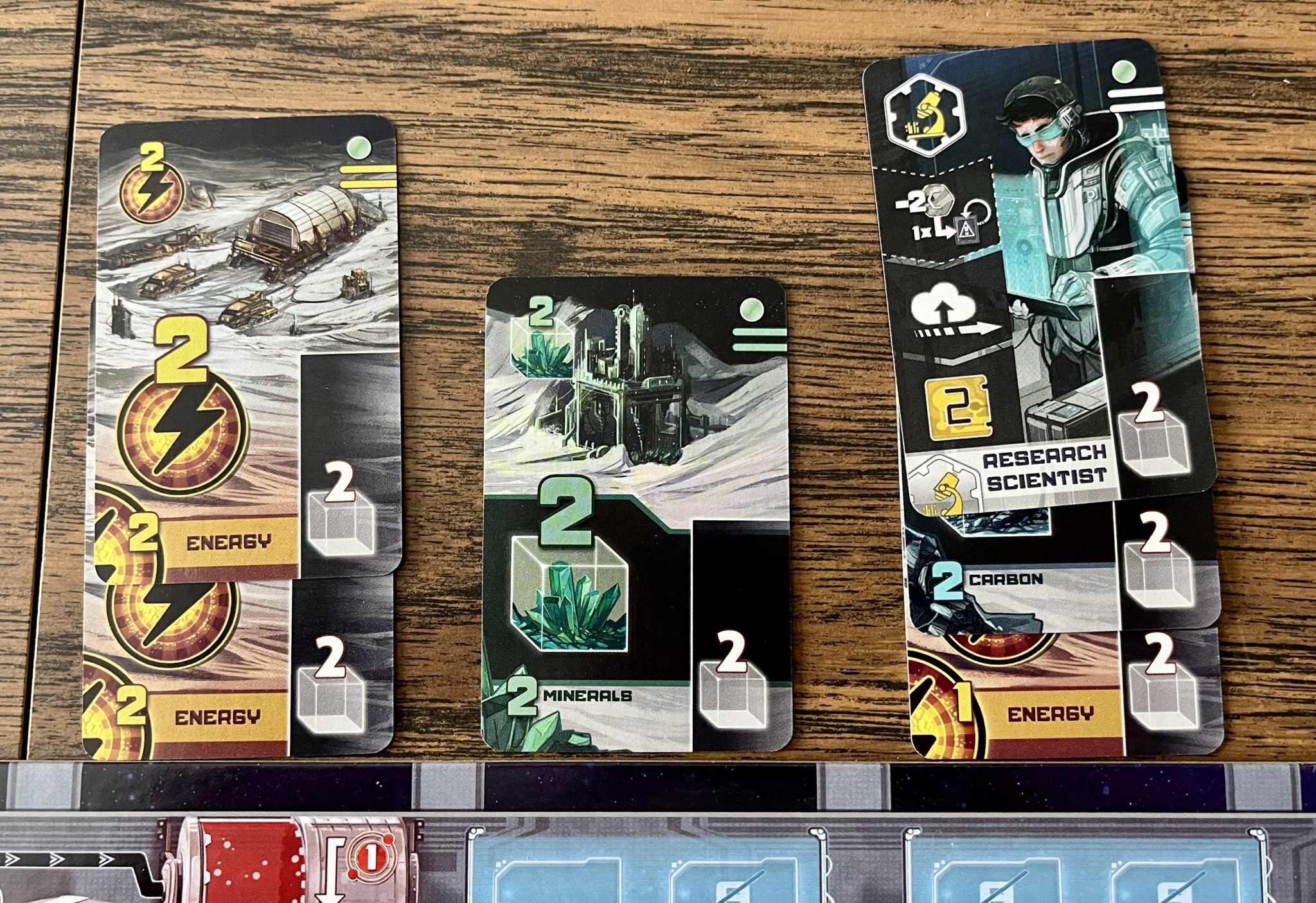
Preparation phase for the next round
The board is reset in a way to start a new round and give players more opportunities with things. A new special research tile is flipped over. All bonus markers from all players are returned. New cards come out into the card display. I won’t go into detail with this phase, but it brings new opportunities that can help players, so pay attention to what cards and tiles come out.
After 7 rounds, the game ends and players will count up their score like I described above. The player who earned the most CrypCoin wins the game.
The Verdict
So the main question you might be asking is if Skymines is better than Mombasa? Well, it depends on what you might expect out of a re-skin. If you are wanting a new theme because you have problems with the other? Then yes you’ll love this. If you are looking for lots of additional content or changes to Mombasa? Then no you won’t like this new re-working. Essentially, I feel like the re-skin is giving players a new theme that they can enjoy. Lots of people like space themed games. And then they kept the base mechanics very similar. Which is great because they worked well and made Mombasa great.
Skymines includes 4 mission campaigns that introduce players to some of the newer changes to the game. This is kind of fun to play through and gives a story along with this short series of games. The main changes to the game is including objectives to give players more of a direction when initially starting the game. There is a second side of the map that changes the game up in that regard. Threat cards can be added that change how players ultimately score at the end of the game if certain threats are not dealt with. This is a fun way to change strategies in the game. But the main mechanics and way to play the game is very similar to Mombasa.
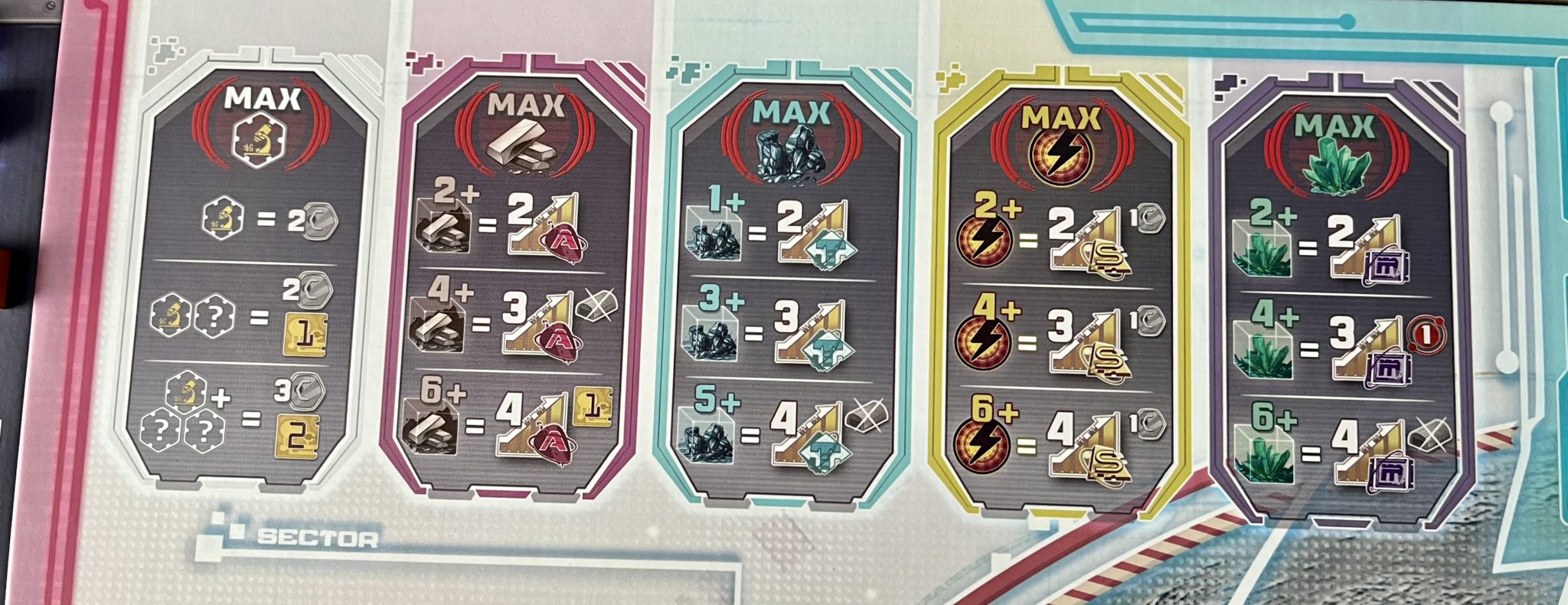
Skymines includes a solo mode called Luna, which I have heard does really well. This can be used when playing solo as well as 2 players, as it mimics another player in the game. I haven’t personally used the Luna variant as it doesn’t personally excite me, but maybe at some time I will try to play the game with it.
The game includes a variety of mechanics, and when Mombasa first came out with all these mechanics, I think it made a lot of noise due to how well the mechanics work together and how many decisions in the game could change so many actions. The game uses card programming, hand management, area majority, stock market simulation, and company building. The game spotlights on the hand management aspect, as it becomes the hero in the game. The game does this by the way you gain card, the way you discard cards, by the way you regain cards, and by the way you choose 3 or possibly more cards at the beginning go each round and use them during the round. The cards aren’t locked in to any specific action, but you have to choose them before the round and during the round you are able to change what you use them for, but you can’t change them for another card in your hand.
If you haven’t played Skymines or Mombasa, this is a game that isn’t too hard to learn or play, but the way you plan and strategize, the cards you play and how you use them increases the complexity of the game. So this would be a great game for medium weight board game lovers who want to try a more complex game as they will be able to understand and feel the differences of actions.
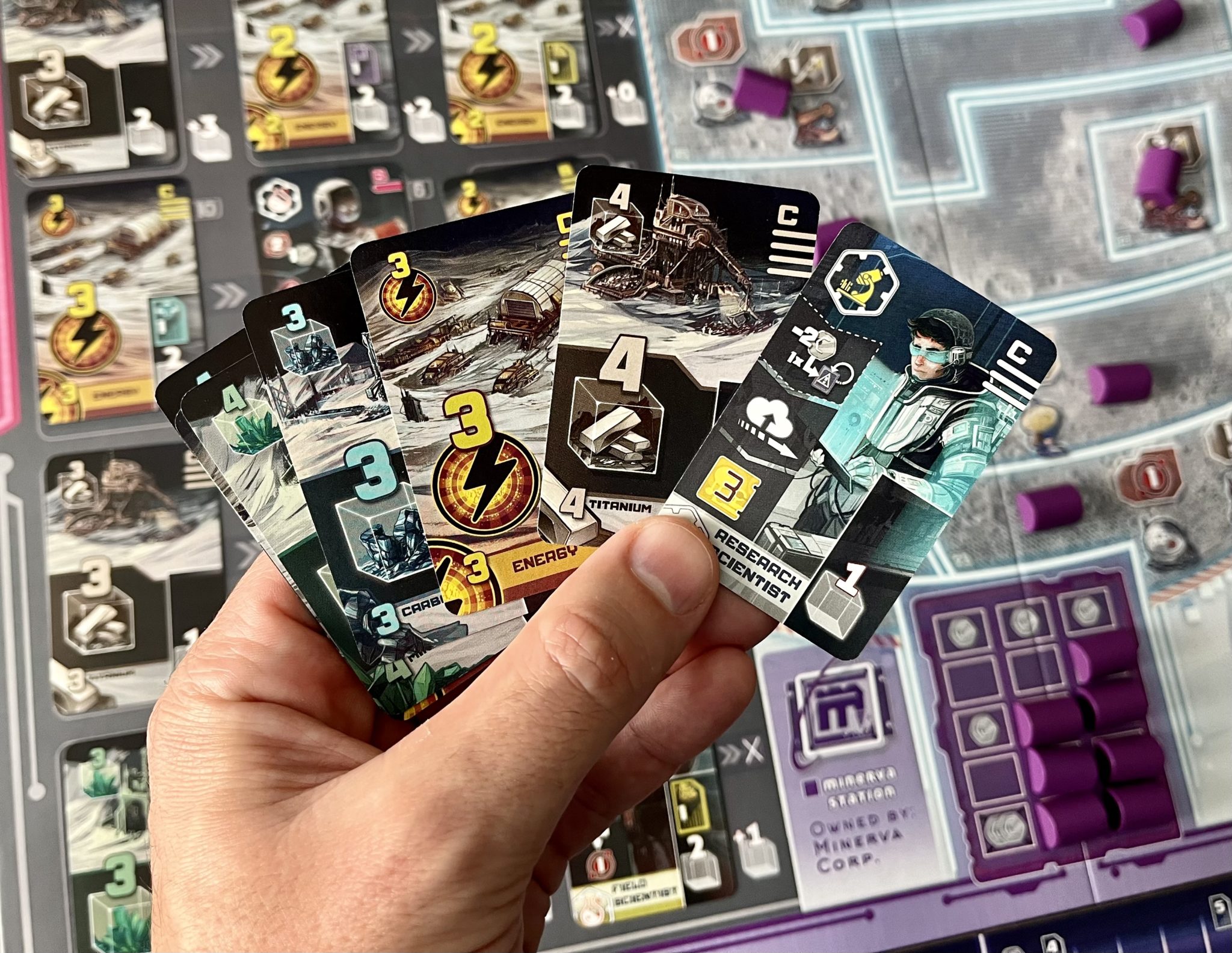
The game also does a great job including a lot of player interaction. Players need to compare majorities all the time to take certain actions. This might delay you in taking a specific action, or make it so you never can take an action you were planning on taking. Also you are competing with players on tracks to gain additional actions or bonuses, and also gaining more stock in a certain company than another player. So, some actions in the game can be dependent on another player and what they are doing.
Now, Mombasa was always a favorite of mine. I taught it to many people throughout the years and I still enjoy playing the game. Skymines takes what I really like and adds just some of those smaller additions that really help the game. I didn’t even realize the game needed these small changes, but it helps. Skymines does a good job building on the mechanics and game play, but also I feel a little more confused on the icons and what everything means when playing the game. Resources looked similar one from another, and icons didn’t stay in my head as I would have liked them to. This caused more visits to the rulebook which slowed down the game.
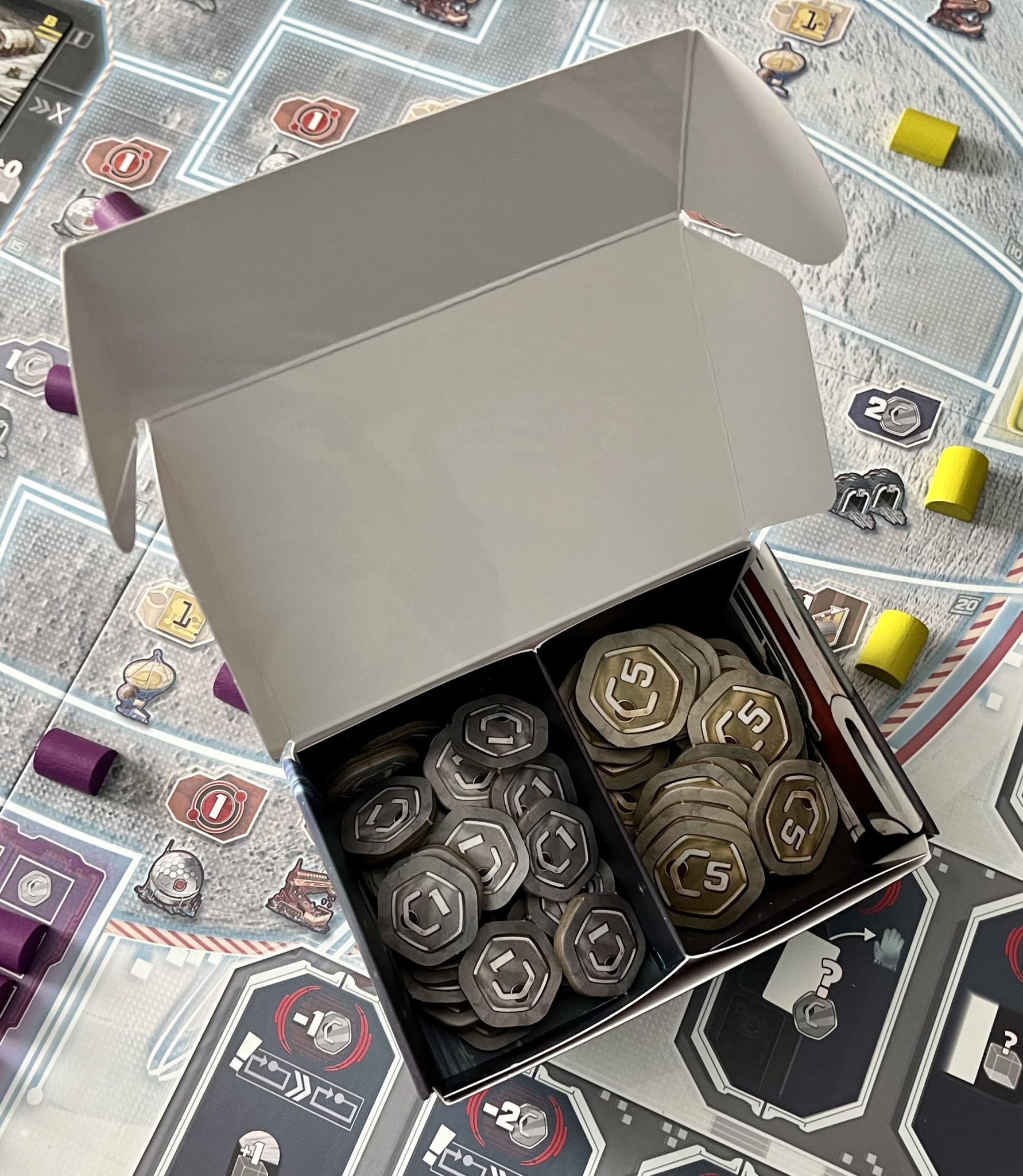
Overall, I think Skymines improves on what is already a board game gem. It adds more variability to the game when you choose to add those things, and adds more value to a game that was already great. The icons and confusion over similar resources can be learned after many plays. So for me, even though the game isn’t perfect, the additions to the game makes the game better. I have very similar feelings when playing Skymines compared to Mombasa. And now I just need to find more and more players who want to continue to play this medium to heavy space themed game that can take a long time to play. But it’s totally worth it at the end.
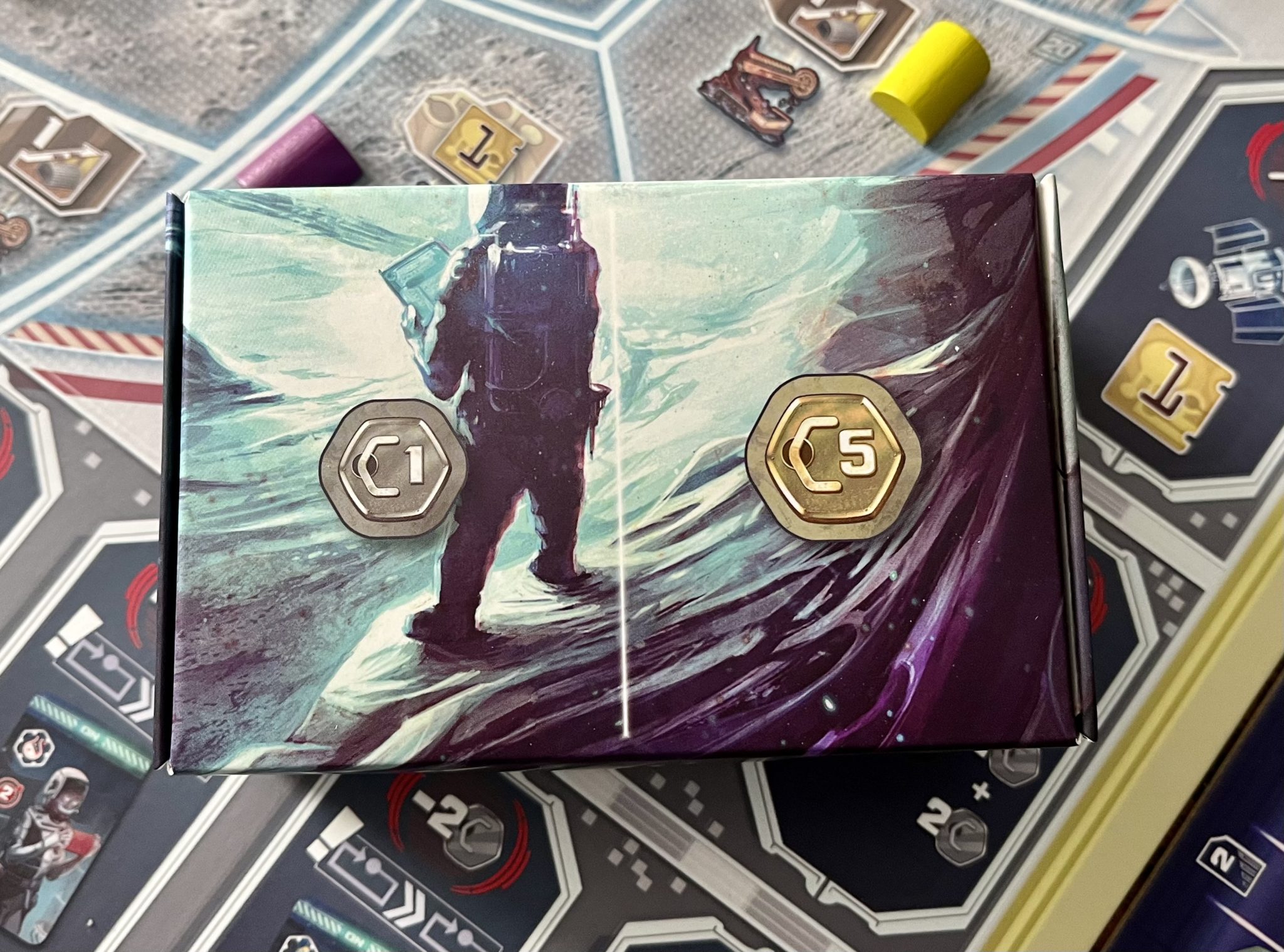
You can order Skymines directly from Pegasus Spiele or from your FLGS, where it’ll run you about $69.99.
Images via Pegasus Spiele
Have strong thoughts about this piece you need to share? Or maybe there’s something else on your mind you’re wanting to talk about with fellow Fandomentals? Head on over to our Community server to join in the conversation!

